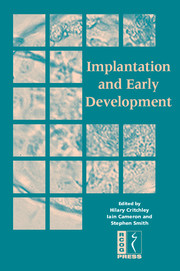Book contents
- Frontmatter
- Contents
- DECLARATION OF INTEREST
- Participants
- Preface
- SECTION 1 PREPARATION FOR IMPLANTATION – THE UTERINE ENVIRONMENT
- 1 Endocrine and paracrine signalling in the human endometrium: potential role for for the prostanoid family in implantation
- 2 Immunology of implantation
- 3 Progestin-indusced decidualisation promotes human endometrial haemostasis and vascular stabulity
- 4 Adhesion molecules and implantation
- 5 Vascular growth and modelling in the endometrium
- 6 Tissue remodelling the fetal-maternal interface: the regulation of matrix metalloproteinase 9 transcription
- 7 Embryo interactions in human implantation
- 8 Experimental models of implantation of the human embryo: reconstructing the endometrial–embryo dialogue in vitro
- SECTION 2 THE EMBRYO
- SECTION 3 LESSONS FROM ANIMAL MODELS (TRANSGENICS) AND NOVEL TECHNOLOGIES
- SECTION 4 CLINICAL SEQUELAE
- SECTION 5 CONSENSUS VIEWS
- Index
5 - Vascular growth and modelling in the endometrium
from SECTION 1 - PREPARATION FOR IMPLANTATION – THE UTERINE ENVIRONMENT
Published online by Cambridge University Press: 05 June 2014
- Frontmatter
- Contents
- DECLARATION OF INTEREST
- Participants
- Preface
- SECTION 1 PREPARATION FOR IMPLANTATION – THE UTERINE ENVIRONMENT
- 1 Endocrine and paracrine signalling in the human endometrium: potential role for for the prostanoid family in implantation
- 2 Immunology of implantation
- 3 Progestin-indusced decidualisation promotes human endometrial haemostasis and vascular stabulity
- 4 Adhesion molecules and implantation
- 5 Vascular growth and modelling in the endometrium
- 6 Tissue remodelling the fetal-maternal interface: the regulation of matrix metalloproteinase 9 transcription
- 7 Embryo interactions in human implantation
- 8 Experimental models of implantation of the human embryo: reconstructing the endometrial–embryo dialogue in vitro
- SECTION 2 THE EMBRYO
- SECTION 3 LESSONS FROM ANIMAL MODELS (TRANSGENICS) AND NOVEL TECHNOLOGIES
- SECTION 4 CLINICAL SEQUELAE
- SECTION 5 CONSENSUS VIEWS
- Index
Summary
The formation of an appropriate circulatory system is a critical step in the development of a multicellular organism. This is self-evident given the numerous critical functions performed by the circulatory system, including oxygen and waste transport, nutritional support, homeostasis and immune defence. This is borne out by the fact that many knockout mice die in utero because of defects in the various components of the circulatory system, such as blood cells, endothelial cells, other cells making up the vascular structures, and cardiovascular defects.
While embryonic development clearly depends on the appropriate vascular structures it is also true that tissue function in adult life depends critically on the appropriate function on endothelial cells. This is particular apparent in tissues that grow rapidly, both normal and pathological. For example, following ovulation the corpus luteum develops rapidly and concurrent with luteal growth is a remarkable degree of angiogenesis. By simply blocking the actions of a single growth factor that is critical to the growth of the luteal endothelial cells, i.e. vascular endothelial growth factor A (VEGF A), luteal growth and function (such as progesterone production) can be abolished. In a pathological setting, the growth of hormone-dependent prostate tumours is dependent on the endothelial cells since upon hormone re-administration it is in fact the endothelial cells that respond before the tumour epithelial cells.
Keywords
- Type
- Chapter
- Information
- Implantation and Early Development , pp. 61 - 69Publisher: Cambridge University PressPrint publication year: 2005

